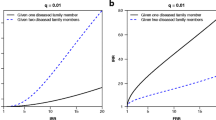Abstract
In case-control studies on familial aggregation of disease, spouses may be chosen as convenient controls. In this article the pros and cons of this control group are discussed. It is argued that the use of spouse controls can be time- and cost-efficient, because of easy accessibility and their ability to provide proxy data on the patients' relatives if necessary. Furthermore, with spouse controls a higher response rate and less recall bias can be expected compared to population controls. A theoretical drawback is the possibility of assortative mating related to genetic susceptibility of the disease under study. Using a simulation study it is illustrated that even strong assortative mating on a factor, which is strongly correlated with a true risk factor under study, will have a negligible effect on the observed extent of familial aggregation.
Similar content being viewed by others
References
Khoury MJ, Beaty TH, Cohen BH. Family studies. In Khoury MJ, Beaty TH, Cohen BH (eds): Fundamentals of Genetic Epidemiology. New York: Oxford University Press, 1993: 164–99.
Rothman KJ. Types of epidemiologic study. In Rothman KJ (ed) Modern Epidemiology. Boston: Little, Brown and Co., 1986: 51–75.
Miettinen OS. The ‘case-control’ study: valid selection of subjects. J Chronic Dis 1985; 38: 543–8.
Kaplan S, Nokikov I, Modan B. A methodological note on the selection of friends as controls. Int J Epidemiol 1998; 27: 727–9.
Wacholder S, Silverman DT, McLaughlin JK et al. Selection of controls in case control studies I. Principles. Am J Epidemiol 1992; 135: 1019–28.
Wacholder S, Silverman DT, McLaughlin JK et al. Selection of controls in case control studies II. Types of controls. Am J Epidemiol 1992; 135: 1029–41.
Mickel SF, Broste SK, Hiner BC. Lack of overlap in genetic risks for Alzheimer' disease and Parkinson' disease. Neurology 1997; 48: 942–94.
Romero Y, Cameron AJ, Locke GR 3rd et al. Familial aggregation of gastroesophageal reflux in patients with Barrett' esophagus and esophageal adenocarcinoma. Gastroenterology 1997; 113: 449–56.
Sellers TA, Ooi WL, Elston RC et al. Increased familial risk for non lung cancer among relatives of lung cancer patients. Am J Epidemiol 1987; 126: 237–46.
Steinberg GD, Carter BS, Beaty TH et al. Family history and the risk of prostate cancer. Prostate 1990; 17: 337–47.
Statistics Netherlands. Statistisch Jaarboek 1998. Nijmegen, The Netherlands: Koninklijke Drukkerij GJ Thieme, 1998.
Allison D, Neale MC, Kezis MI et al. Assortative mating for relative weight: genetic implications. Behav Genet 1996; 26: 103–11.
Botwin, MD. Personality and mate preferences: five factors in mate selection and marital satisfaction. J Personality 1997; 65: 107–36.
Epstein E, Guttman R. Mate selection in man: Evidence, theory, and outcome. Soc Biol 1984; 31: 243–78.
Garrison R, Anderson E, Reed S. Assortative marriage. Soc Biol 1968; 15: 113–27.
Hensley WE. Height as a basis for interpersonal attraction. Adolescence 1994; 114: 469–74.
Ho HS. Assortative mating in unwed-birth parents? Adoptive and nonadaptive parents. Soc Biol 1986; 33: 77–86.
Ober C, Weitkamp LR, Cox N et al. HLA and mate choice in humans. Am J Hum Genet 1997; 61: 497–504.
Rice T, Pérusse L, Bouchard C et al. Familial aggregation of body mass index and subcutaneous fat measures in the longitudinal Québec Family Study. Genet Epidemiol 1999; 16: 316–34.
Spuhler J. Assortative mating with respect to physical characteristics. Soc Biol 1968; 15: 128–40.
Visser O, Coebergh JWW, Schouten LJ et al. Incidence of cancer in the Netherlands 1995. Utrecht, The Netherlands: Vereniging van Integrale Kankercentra, 1998.
SAS/STAT Software. Release 6.12. Cary, North Carolina: SAS Institute, 1997.
Author information
Authors and Affiliations
Rights and permissions
About this article
Cite this article
Verhage, B.A.J., Aben, K.K.H., Straatman, H. et al. Spouse controls in family case-control studies: a methodological consideration. Familial Cancer 2, 101–108 (2003). https://doi.org/10.1023/A:1025737025219
Issue Date:
DOI: https://doi.org/10.1023/A:1025737025219




